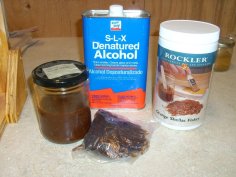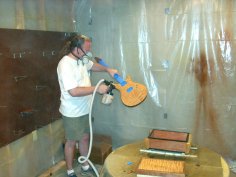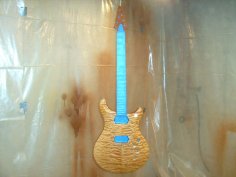 The
purposes of applying sealing coats are twofold. First, you want to
fill in any open pours in the grain so that the lacquer which we’ll
be applying next will lay down perfect and smooth. Second, lacquer
thinner is more or less toxic and it will eat through just about
anything, except shellac. The shellac will seal our previous work
and protect it from any funky chemical reactions we might get from
applying the lacquer directly over the dye and oil. The
purposes of applying sealing coats are twofold. First, you want to
fill in any open pours in the grain so that the lacquer which we’ll
be applying next will lay down perfect and smooth. Second, lacquer
thinner is more or less toxic and it will eat through just about
anything, except shellac. The shellac will seal our previous work
and protect it from any funky chemical reactions we might get from
applying the lacquer directly over the dye and oil.
You can buy premixed shellac, but I prefer to make my own by
dissolving shellac flakes in denatured alcohol. This way I can
control the color and concentration. Shellac flakes come in several
colors: blonde, orange, and garnet. Blonde is very pale and garnet
is pretty dark. We chose the middle tone, orange, to layer on more
of the amber tones. The layering of colors will reflect light
differently emphasizing the three dimensional figure of the wood.
The surface of the guitar will appear to move as you walk past, kind
of like a hologram.
I will make what is called a two pound cut mixture which is
basically just an average concentration of flakes to solvent. When
it’s applied, the solvent will evaporate off leaving the little
dissolved shellac bits behind. The directions on the can of shellac
flakes said for a two pound cut, mix 2 ounces of flakes with 8
ounces of denatured alcohol. Dump them both into an old jar (in our
case, a Frontera Chipotle Salsa vessel, excellent flavor) and shake
them up. Let it sit overnight and shake it some more. It should
completely dissolve in about 24 hours. This should make enough
shellac for the four coats we’ll be applying.
|
Prepare the surface of the wood by throughly wiping it with a tack
cloth to remove any dust. Make sure all of your little holes and
penetrations are filled so they’re not clogged by the following
coats which will be built up. For holes too small for wadded up
tape, try some small screws. To get an even coat, you will have to
spray-apply everything from here on out. There is no way you can
brush or wipe it on and have it look good. To remove any undissolved
shellac flakes, strain your mixture through a disposable paper
filter-funnel or an old T-shirt into your spray gun’s reservoir.
Now for a few comments on spraying technique:
● Please spray in a well ventilated area, your garage, or outside in
the shade somewhere. I wrapped a corner of the basement off with
plastic sheeting. If possible, spray in an area other than your
woodworking shop to cut down on any stray dust getting on your
finish.
● Please wear a good respirator; a cloth dust mask will not do. Just
think about it, shellac and lacquer are specifically designed to
stick to anything and dry hard. That includes your nose, throat, and
lungs. The first time a sprayed something, I did not use a
respirator. The next day I was sick and blowing chunks of stain
filled mucus out my nose. Don’t learn the hard way.
● The solvents used (alcohol and lacquer thinner) are not only
flammable, but in a sprayed state, they are combustible and
explosive. Don’t spray near an open flame (like a cigarette or a
pilot light).
● Test your setup on a piece of scrap wood. Make any adjustments to
your gun before you start messing up your guitar. Get a feel for the
amount of spray and the speed you will need to be moving.
● Be patient! Runs, drips, and sags are bad. If you make any, you
will have to completely sand them out and start over. Don’t try to
rush things or all of your hard woodwork will look like crap.
 ●
Start the gun moving before you pull the trigger. Start spraying
outside your piece and continue past your piece before releasing the
trigger. This constitutes one spray “stroke”. ●
Start the gun moving before you pull the trigger. Start spraying
outside your piece and continue past your piece before releasing the
trigger. This constitutes one spray “stroke”.
● I prefer to hold the guitar while spraying. This lets me keep the
gun relatively level the whole time so that my finish doesn’t leak
or drip on the surface. Do whatever works best for you.
● Try to keep the spray perpendicular to the piece and the same
distance from your piece throughout your spray. This will provide an
even distribution of material. Move quickly to avoid throwing too
much finish in one spot.
● Each stroke should overlap the previous one going back and forth.
It should take about five “strokes” to cover one face of the guitar.
These five or so “strokes” constitutes one “pass”.
● On the same side of the guitar, make another “pass” at 90 degrees
to the first. I’ll call these two “passes” one “coat”. The surface
should just be wet and thoroughly covered. Any more would start to
drip, run, and sag, which would be bad.
● Repeat the procedure on the other side of the guitar. Don’t forget
the sides of the guitar, the headstock, the control cavity cover,
and the truss rod cover.
 ●
Hang the guitar to dry. Nothing fancy here; I used a wire coat
hanger hooked through a tuning peg hole secured to a floor joist
above with an eye-hook. ●
Hang the guitar to dry. Nothing fancy here; I used a wire coat
hanger hooked through a tuning peg hole secured to a floor joist
above with an eye-hook.
● Clean your gun at the end of each day’s spraying.
Schedule for applying the shellac coats:
● Spray on one coat and let the guitar dry for at least one hour.
● Spray on a second coat and let it dry overnight.
● Repeat the process the next day for two more coats (making a total
of four coats).
● Depending on your personal schedule, you can always wait longer.
Just don’t spray any sooner or the previous coat may not be fully
cured.
● The next day, lightly sand the surface as explained in the next
step. |